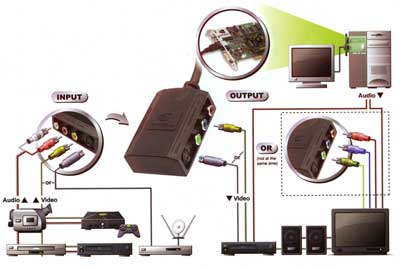eVGA Personal Cinema FX5700
The Card and Setup
|
At first look, you almost forget that you are looking at a hybrid TV/Video card. The tuner component chosen for the Personal Cinema is roughly one inch square in size, much smaller than what we typically see with competitor's TV products. Below we've lined-up a comparison image with the ATI All-In-Wonder 9600XT we reviewed recently which is indicative of the typical size of the tuner used on ATI cards. The reduced size does not sacrifice functionality, offering a full 125 channel line-up and FM tuner capability while maintaining good image quality. Another by-product of the smaller tuner module is less heat being generated, where as the larger components can get quite toasty.
At the heart of the card is NVIDIA's GeForce FX 5700 GPU clocked at 425MHz which is coupled with 128MB of DDR memory set to run at 550MHz DDR (effective). eVGA used Samsung K4D261638E-TC36 memory modules which are rated for 550MHz, leaving no additional headroom for overclocking. Often we see manufacturers clock down the chips from there peak, possibly in anticipation of overclocking, but eVGA opted to run the memory at the speed it was designed for. Nonetheless, a little later on we'll give overclocking a try and see what gains can be had with these particular memory chips.
The rear of the card comes with two F-Type connectors, the first for the integrated TV-Tuner and the second for connecting the provided FM Antenna. Next, was a 10-Pin VIVO and Audio-In port that marries with the A/V Breakout Box to support a multitude of inputs and outputs as shown in the diagram below.

Below the VIVO port is the card's audio out which connects to the sound card or integrated audio of the system with a 1/8" male x 1/8" male adapter cable which is provided in the bundle as well. The default video output is DVI although eVGA did include an adapter for analog monitor support.

Rounding out the package was the NVIDIA Remote Control, which is a Radio Frequency based remote, eliminating the need for line-of-sight operation like infra-red remote controls. The NVIDIA Remote Control is preconfigured to control all facets of the ForceWare Multimedia software as well as being programmed to work with common programs such as PowerPoint, MusicMatch and Real Player to name a few. Once the drivers have been installed, a shortcut to the remote control settings can be found in the Windows Control Panel where the remote can be configured for additional applications and various adjustments.
|
When it comes to software installation, eVGA does a great job of simplifying the process with a clean menu interface that's easy to follow. When we inserted the first CD, a Media Menu appeared with links to the drivers, electronic manuals and supporting software. We simply clicked the Install Video Drivers link and we were on our way. The ForceWare drivers and multimedia software completed installation in a matter of a few minutes. After a reboot and subsequent hardware detection, we were on our way to using the Personal Cinema FX 5700. What was interesting was how eVGA did not make the ULEAD software an option, instead having them integrated into the software installer. The approach here is a little different than what we are used to. This is not bonus software, but rather components integrated into the complete package, making them required for complete functionality.
Once the installation process completed, we could access each of the software components from another clean, easy to read Media Menu. Each link opened its respective ForceWare Multimedia component, except for the "Edit a Movie" and "Burn a Movie" which launched either ULEAD DVD MovieFactory or VideoStudio 7.












